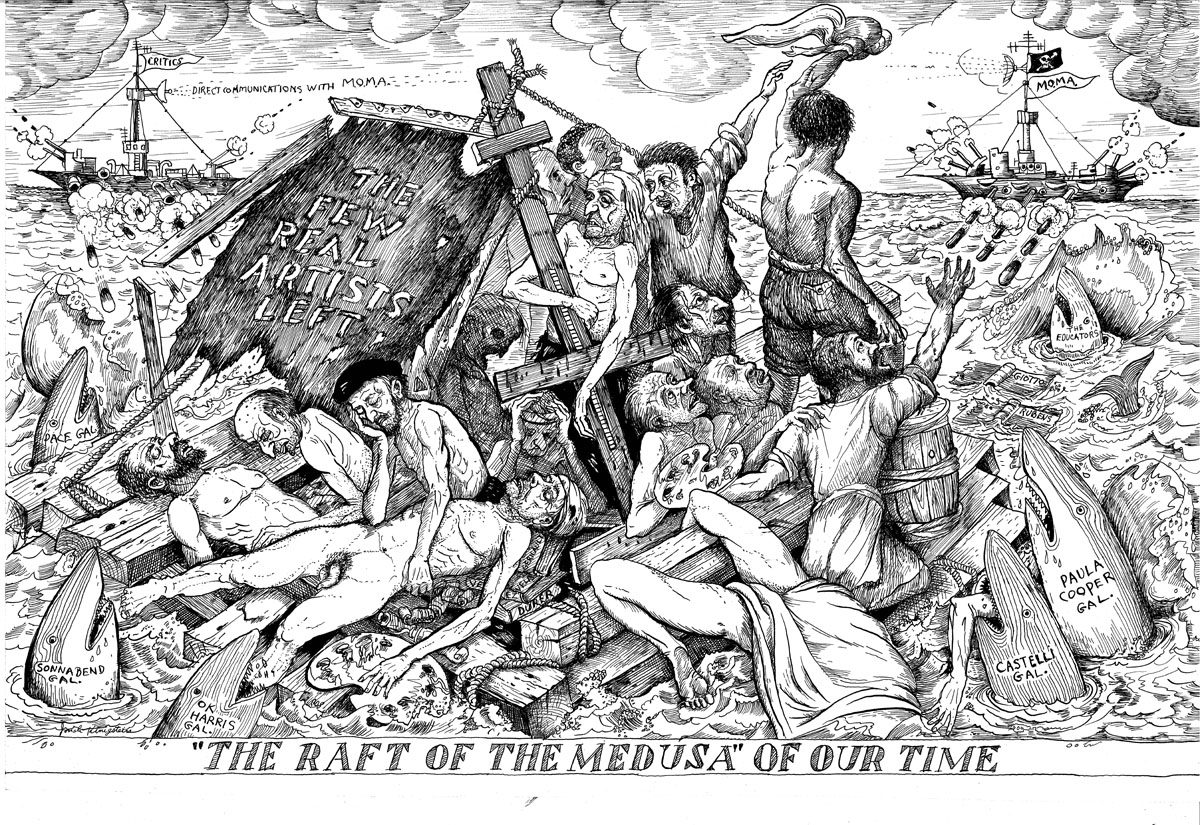The New York Comics & Picture-Story Symposium is a weekly forum for discussing the tradition and future of text/image work. Open to the public, it meets Tuesday nights 7-9 p.m. EST in New York City. Presentations vary weekly and include everything from historical topics and technical demonstrations to creators presenting their work. Check out upcoming meetings here.
The 113th meeting of the NY Comics & Picture-Story Symposium was held on Tuesday, February 3, 2015 at 7 p.m. at Parsons The New School, 2 West 13th Street. Jonah Kinigstein discussed his recent book called The Emperor’s New Clothes.
I.
“Essentially, I’m a painter and I’ve painted all my life,” Jonah Kinigstein announced with full Al Pacino swagger. Then he shrugged as if to say, “That’s the whole story, folks.” It was the 113th meeting of the NY Comics & Picture-Story Symposium and this 92-year old Coney Island native who once lived next door to 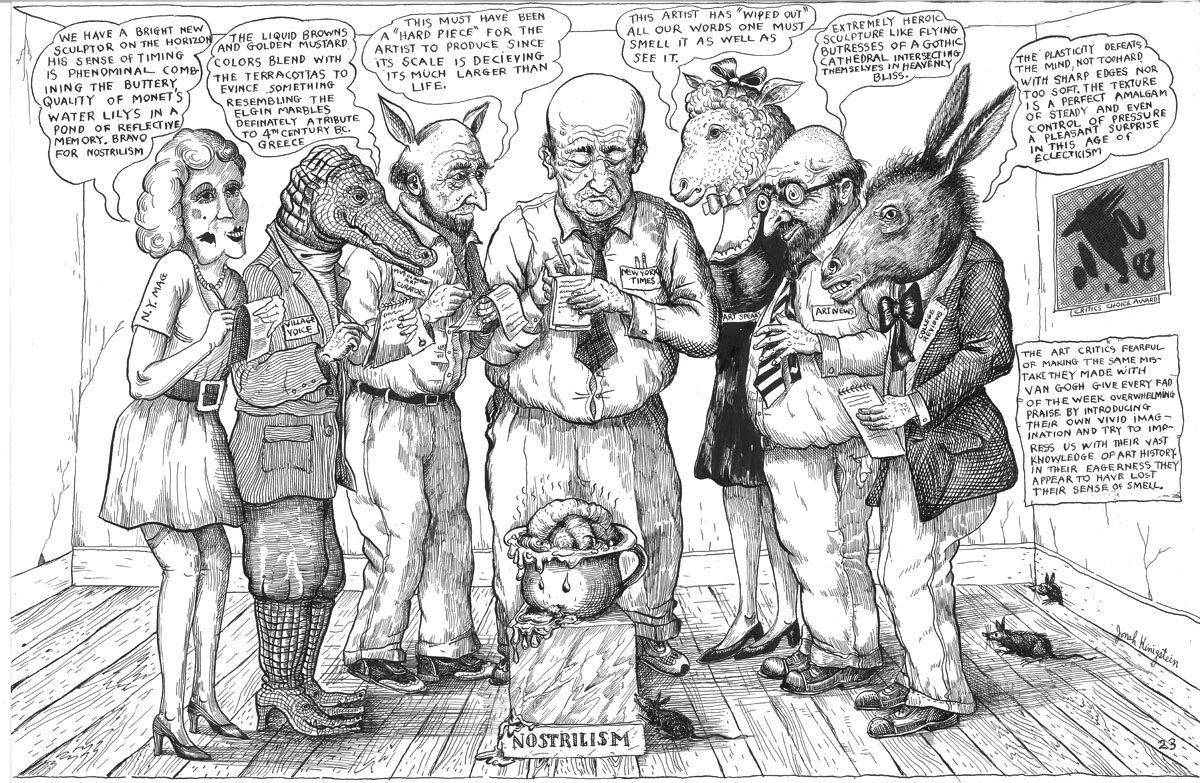 Brancusi in Paris, evaded a fist fight with Jackson Pollack at the Cedar Tavern, and very recently spent his nights wheatpasting his artwork all over Soho, was trying to pull a fast one on us.
Brancusi in Paris, evaded a fist fight with Jackson Pollack at the Cedar Tavern, and very recently spent his nights wheatpasting his artwork all over Soho, was trying to pull a fast one on us.
His scarf hung from his neck—again, Pacino-style—as he went on to describe his lifelong frustrations with the Art World. As a committed figurative painter, he felt ostracized by this exclusive group during a time when cultural behemoths like Leo Castelli, Mary Boone, and Clement Greenberg were radicalizing the known landscape of art. With the introduction of Abstract Expressionism, Surrealism, Pop Art, Op Art, Conceptual Art, and Neo-Dadaism, Kinigstein was at a loss. He jokingly summarized that kind of work as “a couple of rocks glued together with gum—a masterpiece!”
II.
He came to the Symposium that night to talk about his book, The Emperor’s New Clothes: The Tower of Babel in the “Art” World, and an exhibition of his work by the same name at the Society of Illustrators, 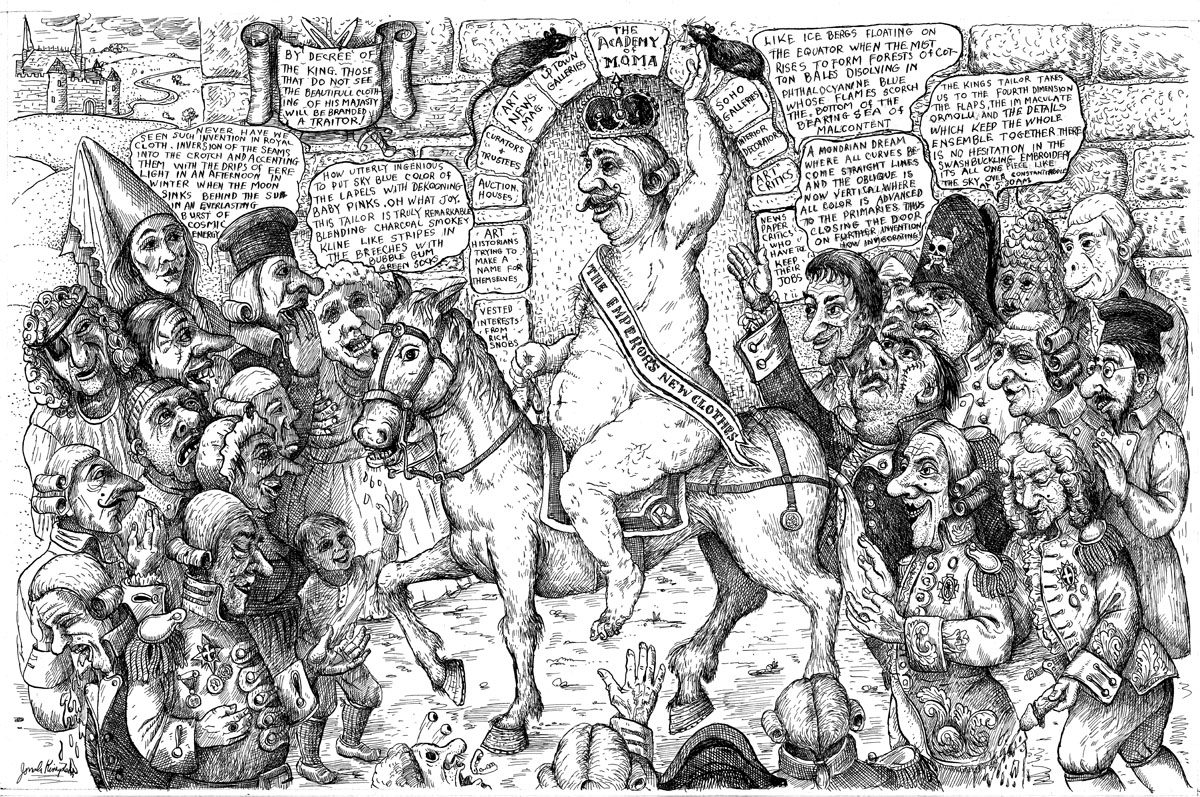 which closed February 7. The 80-page softcover book is one of the first two published by Fantagraphics Underground Press (FU Press), a new micro imprint of its parent company. FU Press was established in 2014 with the intention of publishing books and projects by relatively unknown cartoonists—work that is innovative, off-kilter, or downright crazy.
which closed February 7. The 80-page softcover book is one of the first two published by Fantagraphics Underground Press (FU Press), a new micro imprint of its parent company. FU Press was established in 2014 with the intention of publishing books and projects by relatively unknown cartoonists—work that is innovative, off-kilter, or downright crazy.
Vacillating between cool detachment and rolling crescendos of intensity, Kinigstein was an amusing tour guide. He lead the rapt audience on a slide show circuit of scathing riffs found in many of the book’s drawings. Each drawing functions a lot like excerpts from a massive hit list of all the people and institutions he’d like to whack.
Kinigstein’s targets are very clear. He hits art institutions like the MoMA, the Whitney, the Guggenheim, and DIA; gallerists Mary Boone and Leo Castelli; artists Andy Warhol, Robert Rauschenberg, Jasper Johns, Willem de Kooning, Jackson Pollock, Franz Kline, Damien Hirst, and Julian Schnabel; critic Clement Greenberg 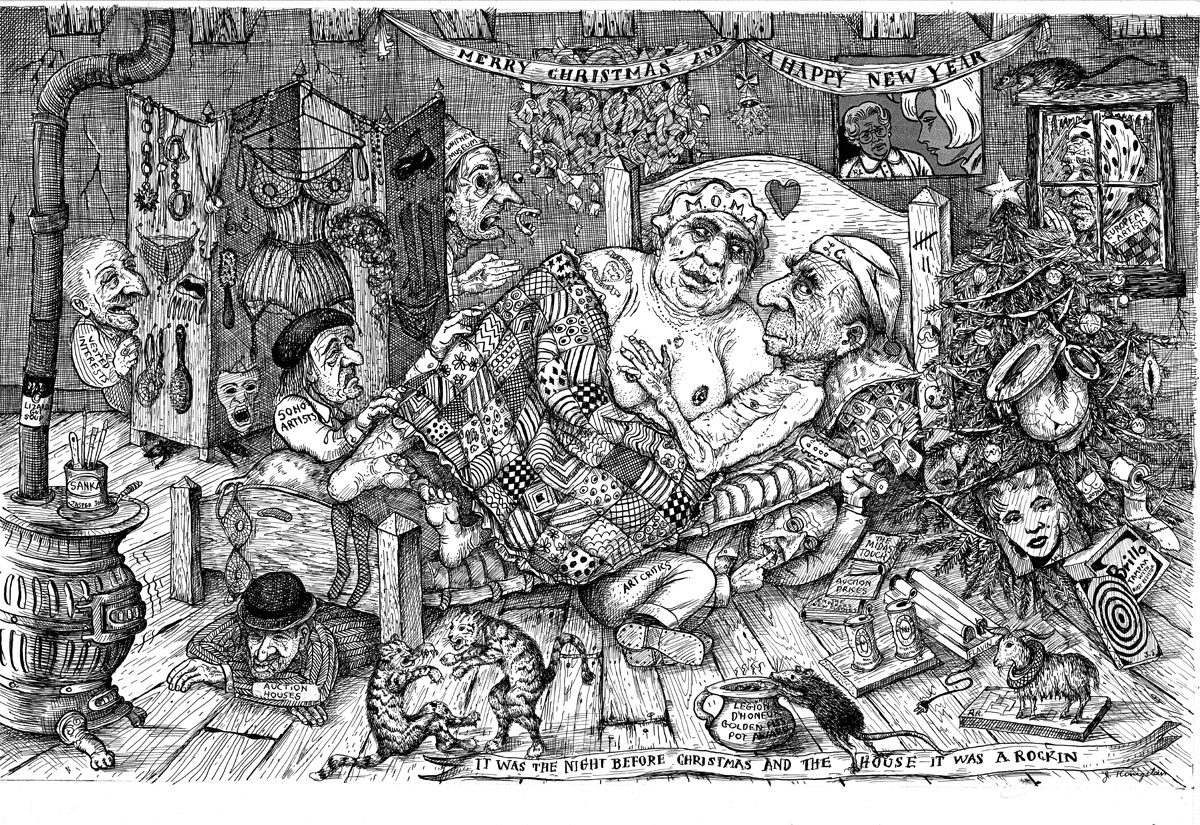 and art critics in general; all curators; most galleries; IBM, the New York Times, Newt Gingrich, and most frequently, Marcel Duchamp. “They’re all in bed together,” he explains as he refers us to the drawing, Merry Christmas and a Happy New Year. Mother “MoMA” is sleeping with father “Leo Castelli” while art critics and auction houses hide beneath the bedsprings taking notes. “Soho Artists” attempt to interrupt the conjugal partnership, begging for attention from the patron parents like bratty children. European artists observe from the window, wanting badly to be let in from the cold.
and art critics in general; all curators; most galleries; IBM, the New York Times, Newt Gingrich, and most frequently, Marcel Duchamp. “They’re all in bed together,” he explains as he refers us to the drawing, Merry Christmas and a Happy New Year. Mother “MoMA” is sleeping with father “Leo Castelli” while art critics and auction houses hide beneath the bedsprings taking notes. “Soho Artists” attempt to interrupt the conjugal partnership, begging for attention from the patron parents like bratty children. European artists observe from the window, wanting badly to be let in from the cold.
In The Raft of the Medusa of Our Time, “the few real artists of our time” struggle to stay alive on an overcrowded ramshackle raft, as gallery sharks snap at their feet. Pace, Paula Cooper, and OK Harris number among the toothy predators. Cannon shots fire at the endangered artist colony from pirate ships in the distance labeled “MoMA” and “Critics.” A single shark placed midway between the feeding frenzy and the ships bears the title of “The Educators.” When asked about this Kinigstein says simply, “Josef Albers was not a lesser shark.”
Throughout the work, Duchamp is the artist who takes the brunt of Kiligstein’s aggressions. He thinks of him as the main culprit in the downfall of his beloved figurative art. He punches Duchamp squarely in the jaw with Demons of the Avant Garde Planet Duchamp Come to Rape Figurative Art. In The Apotheosis of Marcel Duchamp, the artist is elevated to sainthood and “Soho Dealers,” “Museum Curators,” and “General Purpose Snobs” pray to the be-winged art star. R. Mutt urinals appear so regularly in 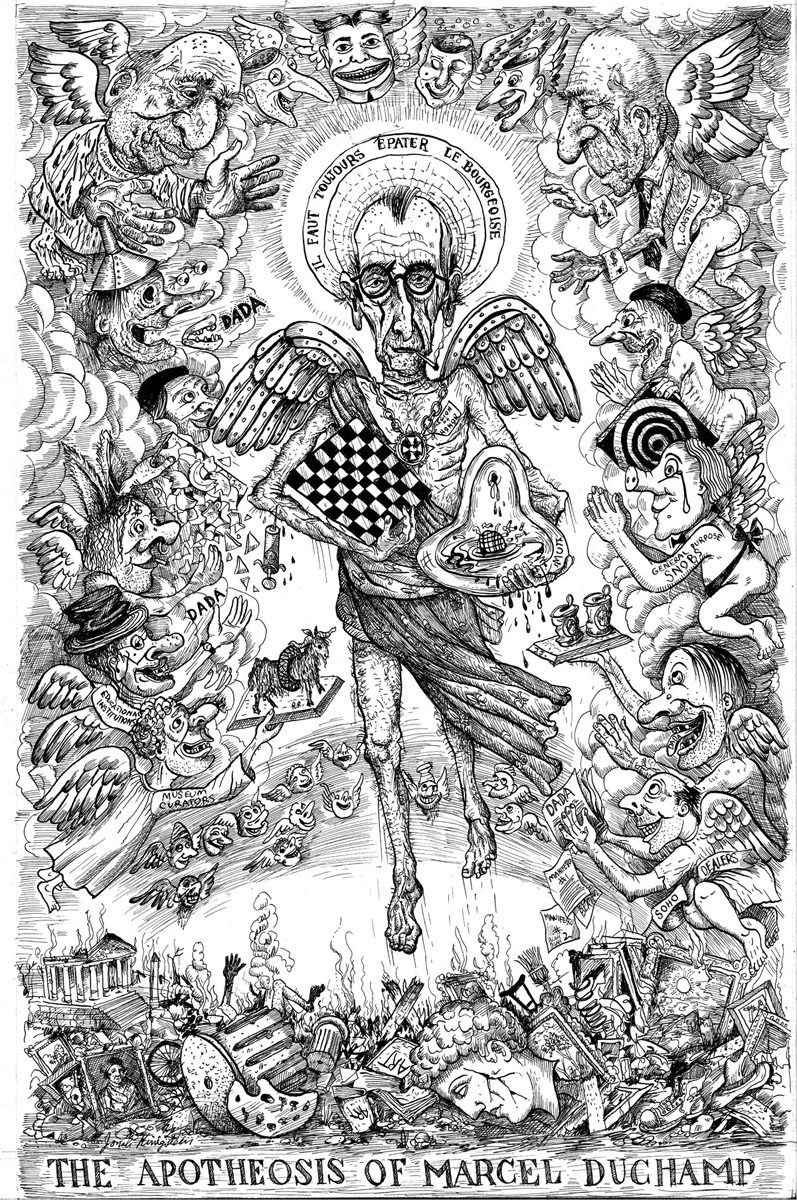 his drawings that they start to feel like part of a “Where’s Waldo” scavenger hunt. While the Art World generally credits Duchamp as a pioneer of 20th century creative advancement, Kinigstein clearly sees him as a phony and an enemy.
his drawings that they start to feel like part of a “Where’s Waldo” scavenger hunt. While the Art World generally credits Duchamp as a pioneer of 20th century creative advancement, Kinigstein clearly sees him as a phony and an enemy.
III.
Stylistically, the drawings exist at the crossroads of Thomas Nast and Aline Kominsky-Crumb. Like Kinigstein’s drawings, Nast’s seething cartoons of the 1870s left no meaning to chance—stamping his visual metaphors with literal bullseyes: anvils hanging from Lady Liberty’s neck are inscribed “Income Tax,” and elephants always appear pre-embossed with “The Republican Vote.”
The drawings have the frenzied grotesqueness and, at times, wordiness of Kominsky-Crumb’s underground comics. They have the boldness of her exaggerated emotions and are ridiculous and carnivalesque. They do what cartoons and underground comics have historically done so well—address the elephant in the room and call it by name. Literally. They dare to push back against what the rest of us assume is untouchable or unsayable.
IV.
Kinigstein—whether he agrees or not—is much more than a painter and his book and exhibition are both testaments to that. To call him a cartoonist or a street artist is beside the point. To call Lenny Bruce “just a comedian” is, too.
He got angry, so he made these drawings. He got down into the dirty details of a deep, dark obsession, and he came up with this illuminating and humorous work. He hated the ridiculousness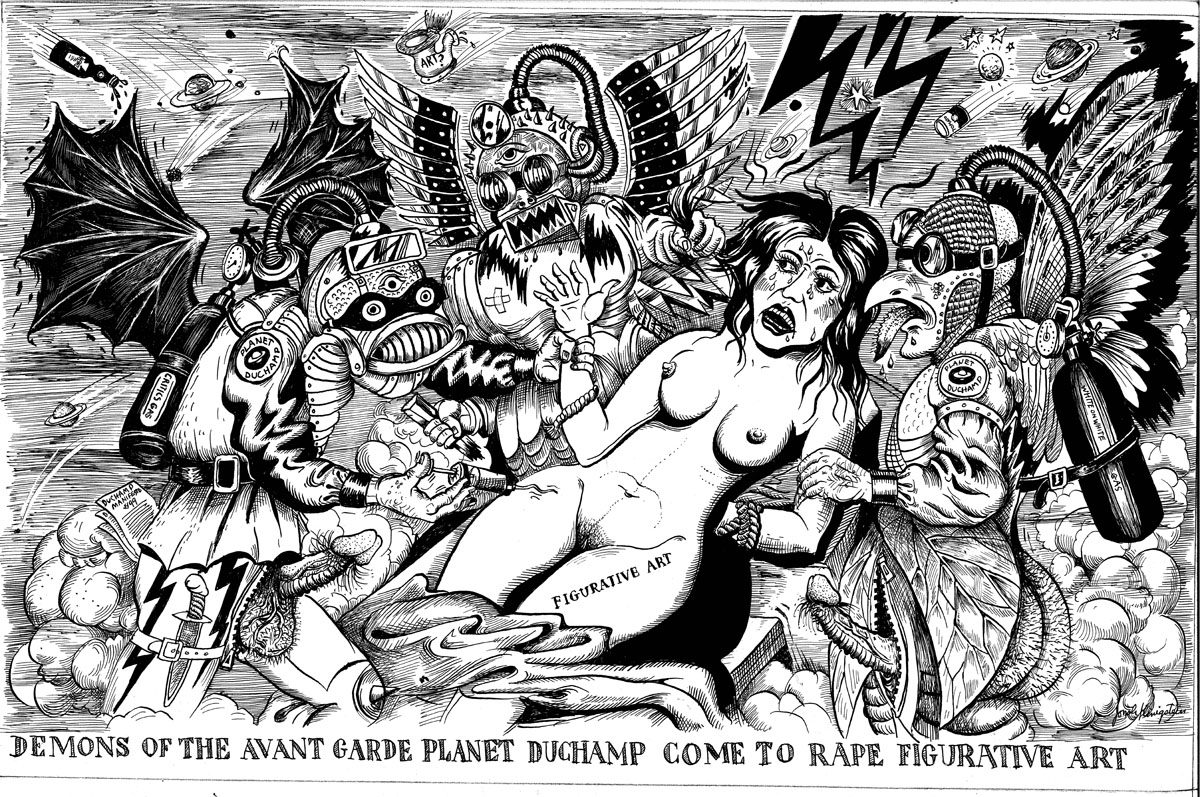 of modern art making, and so he railed against it with his own brand of ridiculousness. Admittedly, he thinks the drawings are absurd.
of modern art making, and so he railed against it with his own brand of ridiculousness. Admittedly, he thinks the drawings are absurd.
While the targets of Kinigstein’s battle are so anachronistic as to be unrecognizable to a younger generation, there is something about his work that is both refreshing and relevant. Similar to Lenny Bruce’s time, we’re in a moment of history where the pressure to be positive can feel stifling. Kinigstein’s work is a welcome relief from that. To be critical is not a bad thing.
Even so, Kinigstein relents with another shrug, “Maybe I hit ‘em too hard. I don’t know.”
***
All images © Jonah Kinigstein, The Emperor’s New Clothes: The Tower of Babel in the “Art” World, Fantagraphics, 2015.
***
About the Author: Monica Johnson is a comic artist and student debt activist living in Brooklyn, NY. She holds an MFA in Integrated Media Art from Hunter College. She self-publishes mini-comics through Wool & Brick Press, and is working on a full-length graphic novel titled The Adventures of Dorrit Little, a tale of the average student debtor in the United States today. Connect via @woolandbrick.

